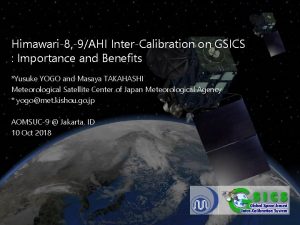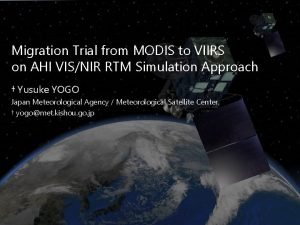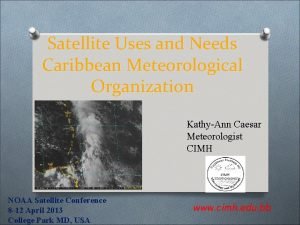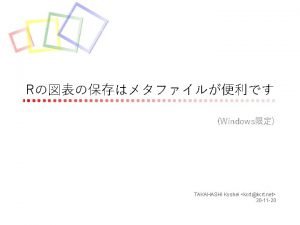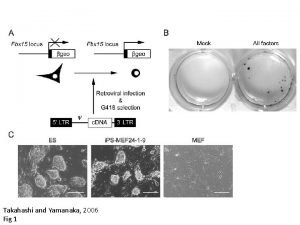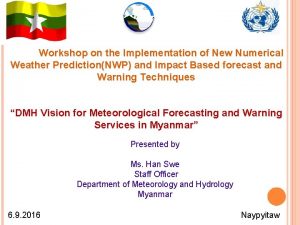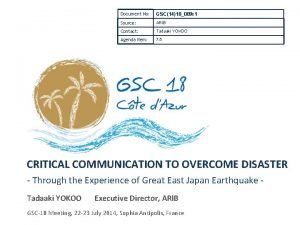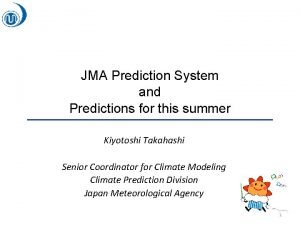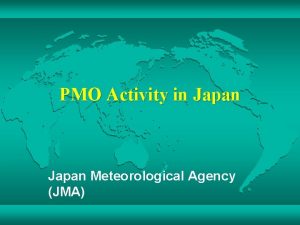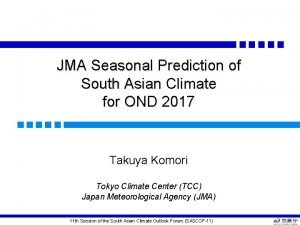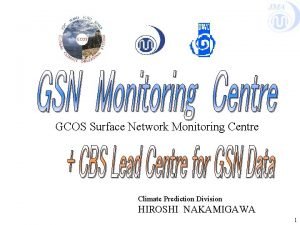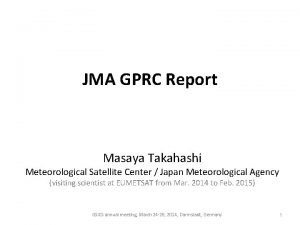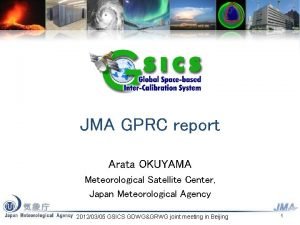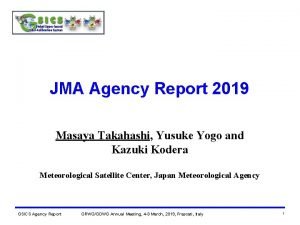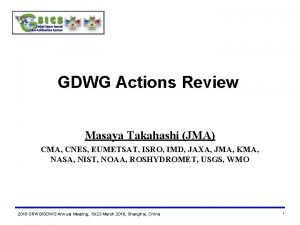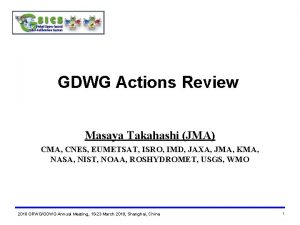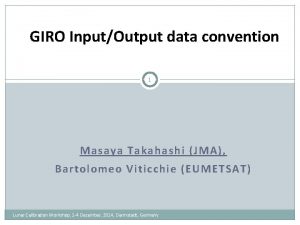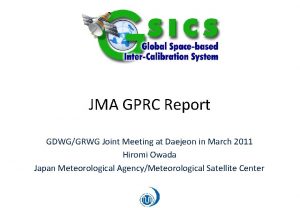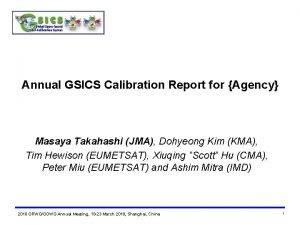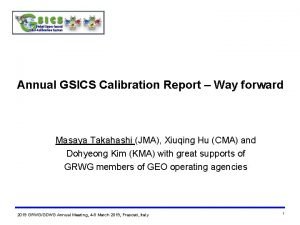JMA GPRC Report 1 Masaya Takahashi Meteorological Satellite













- Slides: 13

JMA GPRC Report 1 Masaya Takahashi Meteorological Satellite Center/ Japan Meteorological Agency GRWG/GDWG Annual Meeting, Mar. 04 -08, 2013, Williamsburg

Contents 2 n Events since the last Joint meeting @ Beijing p Member change p Back up operation by MTSAT-1 R n GSICS correction for Infrared channel p Format change GSICS Correction for MTSAT infrared channels p Uncertainty analysis n Visible vicarious channel calibration using RTM p For Pre-MODIS era n Himawari-8/9: Next generation JMA’s geostationary satellites p Overview p NRT distribution of both the operational and corrected calibration information GRWG/GDWG Annual Meeting, Mar. 04 -08, 2013, Williamsburg

Events since the last Joint meeting @ Beijing 3 Member change New members Masaya Takahashi: GRWG, contact person JMA GPRC Tetsuro Kurita: GDWG Previous members Arata Okuyama Yuki Kosaka GRWG/GDWG Annual Meeting, Mar. 04 -08, 2013, Williamsburg

Events since the last Joint meeting @ Beijing 4 Back up operation by MTSAT-1 R • October to December 2012: JMA conducted a maintenance of the MTSAT’s ground system. During the system maintenance, 18 October to 26 December, MTSAT-1 R was brought back into meteorological observation. Observation schedule: http: //mscweb. kishou. go. jp/operation/status/mtsat. htm This event is planned every year in the same season. MTSAT-2 IR 1(10. 8 um) TB Bias monitoring GRWG/GDWG Annual Meeting, Mar. 04 -08, 2013, Williamsburg

GSICS correction for infrared channel 5 n Current status of MTSAT-1 R/-2 IR GSICS correction p Demonstration phase, started in July 2010 p Reference sensor: Metop-A/IASI and Aqua/AIRS n Toward the implements to Pre-Operational phase p Additions and modifications to the net. CDF conventions • data disclaimer statement, id, …: According to the net. CDF template • Tb/Radiance conversion formulas: To meet the requirement of bias plotting tool p Combine of NRTC files: Will be done by this March p Uncertainty evaluation: see tomorrow’s GRWG session GRWG/GDWG Annual Meeting, Mar. 04 -08, 2013, Williamsburg

Visible vicarious channel calibration using RTM (Details will be talked on Thursday) 6 n Method: Comparison of observed and Result of MTSAT-2 in Feb. 2011 simulated radiance for some targets reliable regression line p Cloud-free ocean, Cloud-free land, Liquid water cloud, DCC n Radiative transfer calculation: p RSTAR (Nakajima and Tanaka [1986, 1988]) Simulated reflectivity n Target: Wide range of TBB in order to obtain n Input data: Independent from GEO data p JMA Re-Analysis atmos. profiles, MODIS L 1 B, BRDF, Aura/OMI total column ozone, … Observed reflectivity Expansion to the pre-MODIS era and near infrared channels of Himawari-8/-9 This work have been done as part of a research program conducted in collaboration with the University of Tokyo, the visible channel calibrations of GMS and MTSAT satellites. GRWG/GDWG Annual Meeting, Mar. 04 -08, 2013, Williamsburg

Himawari-8/9: Next generation JMA’s geostationary satellites 7 Advanced Himawari Imager (AHI) Band Central Wavelength [μm] Spatial Resolution 1 0. 43 - 0. 48 1 Km 2 0. 50 - 0. 52 1 Km ● 3 0. 63 - 0. 66 0. 5 Km ● 4 0. 85 - 0. 87 1 Km ● 5 1. 60 - 1. 62 2 Km 6 2. 25 - 2. 27 2 Km ● 7 3. 74 - 3. 96 2 Km ● 8 6. 06 - 6. 43 2 Km 9 6. 89 - 7. 01 2 Km ● 10 7. 26 - 7. 43 2 Km ● 11 8. 44 - 8. 76 2 Km ● 12 9. 54 - 9. 72 2 Km ● 13 10. 3 - 10. 6 2 Km 14 11. 1 - 11. 3 2 Km ● 15 12. 2 - 12. 5 2 Km ● 16 13. 2 - 13. 4 2 Km NIR n “Himawari”: a nickname of JMA’s GEO satellites, meaning sunflower in Japanese n JMA plans to launch Himawari-8 in 2014 and begin its operation in 2015. The launch of Himawari-9 is also planned in 2016. n AHI (Advanced Himawari Imager) has 16 bands n 10 minutes for full disk observation, 2. 5 minutes around Japan as of MTSAT-1 R/2 ●: MSG Band Central Wavelength [μm] Spatial Resolution 1 0. 55 – 0. 90 1 Km 2 3. 50 – 4. 00 4 Km 3 6. 50 - 7. 00 4 Km 4 10. 3 – 11. 3 4 Km 5 11. 5 – 12. 5 4 Km

MSC web page for Himawari-8/9 information including “AHI SRFs (Spectral Response Functions)” 8 n Himawari-8/9 information web page opened at MSC website n “engineering” SRFs of AHI are available http: //mscweb. kishou. go. jp/ (1) Click a link: “Himawari-8/9” (2) Click a link: “Imager (AHI)” (3) You can get “AHI SRFs” GRWG/GDWG Annual Meeting, Mar. 04 -08, 2013, Williamsburg

Simulated AHI images for new products development 9 To support the development of Himawari-8/9 products such as AMV, SST and aerosol, simulated satellite images are necessary. RT simulated images for Himawari-8/9’s 16 AHI bands a Radiance for each AHI band is calculated by using RTM with JMA NWP and some LEO satellites data. a Sample simulation data have been made public for use in AHI research and development on the website. Configuration for RT Simulation RT Model NWP RSTAR (Nakajima and Tanaka, 1986) JMA GSM (horizontal resolution: 20 km) Surface Wind: JMA GSM Parameters Albedo: MODIS MOD 09 GRWG/GDWG Annual Meeting, Mar. 04 -08, 2013, Williamsburg

NRT distribution of both the operational and corrected calibration information 10 Action EP-12. 05: “Each GPRC to consider implementing the near real time distribution of both the operational calibration information and the corrected calibration information, as part of the L 1 data formats” For MTSAT : Difficult to include it For Himawari-8/-9: Now under consideration Tentative plan of calibration information included in Himawari-8/-9 NRT provision data n Correction coefficients against one reference sensor n Coefficients used in a conversion of TBB/radiance n Window period to be used in a regression n Ancillary information (text block) p Calibration method, reference sensor name, … GRWG/GDWG Annual Meeting, Mar. 04 -08, 2013, Williamsburg

Summary and future plan 11 n Annual back up operation by MTSAT-1 R p From October to December, 2012 n Works to move MTSAT IR correction into Pre-operational phase n Visible vicarious calibration n Himawari-8/9 p Information of GSICS correction will be included in NRT distribution. p Calibration method for visible channel will be expanded to the NIR channel. n GMS-5 Re-calibration p Planned in the framework of SCOPE-CM phase 2 project: “Inter-Calibration”. JMA’s GSICS products timeline (found on GSICS wiki) GRWG/GDWG Annual Meeting, Mar. 04 -08, 2013, Williamsburg

Backup slides 12 GRWG/GDWG Annual Meeting, Mar. 04 -08, 2013, Williamsburg

A Sequence of Himawari-8/9 AHI Observation in 10 minutes Time Frame 13 Full Disk Observation in every 10 min. Over Japan (1) Over Japan (2) every 2. 5 min. Typhoon monitoring every 2. 5 min. Land-mark extraction (1) extraction (2) every 30 sec. A combination of one "Full Disk" and "small sectored" Imagery in 10 minutes GRWG/GDWG Annual Meeting, Mar. 04 -08, 2013, Williamsburg
